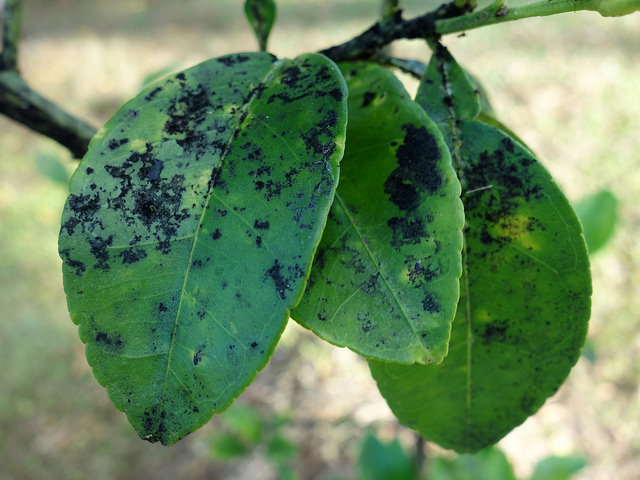Introduction:
Sooty mold is a collective term applied to several species of dark fungi. The fungi grow on honeydew excreted by insects, or exudates from leaves of certain plants. Sooty mold growths are composed of fungal complexes consisting of ascomycetes, and fungi imperfecti. Some of the common genera include Aureobasidium, Antennamariella, Limacinula, and Capnodium.
Description & Causes:
Sooty mold is a dark, thread-like growth that gives plants or other substrates the appearance of being covered with a layer of soot. Many sooty mold fungi have mucilaginous cell walls that help them adhere to the surfaces on which they grow. These cell walls serve another purpose: they absorb moisture, enabling sooty mold fungi to prolong periods of wetness.
The species of sooty mold vary depending on three major factors: the environment, the host, and the type of insect present. Some sooty molds are host or insect specific; others colonize many types of plants or surfaces, and use honeydew produced by several kinds of insects.
Honeydew is a sweet, sticky liquid excreted by certain insects as they ingest large quantities of sap from a plant. These insects include aphids, leafhoppers, mealybuds, psyllids, soft scales, and whiteflies. Both the immature and adult stages of these insects feed by extracting sap from plants. They assimilate some of the nutrients contained in the sap, excreting the rest as honeydew. Insect honeydews contain sugars, amino acids, proteins, minerals and vitamins, all of which contribute to fungal growth.
Wherever honeydew is placed, sooty molds can become established. Honeydew can be found on leaves, branches, fruits, vegetables, concrete, sidewalks, and outdoor fixtures. It is commonly observed on the leaves of ornamental plants such as azaleas, lilacs, gardenias, camellias, and laurels. It may also be found on plants located under pecan, maple or hickory trees. Occasionally, citrus plants may exude sticky secretions, upon which sooty mold may form.
Sooty mold growth appears in two types. The first type is a deciduous growth that forms on leaves. This type survives until the leaf expires. The second type is more persistent, developing on the stems and twigs of plants, as well as various structures. Fungal growth becomes more pronounced during warm, dry conditions. On foliage undergoing moisture stress, insect populations and honeydew production may increase.
Effects of Sooty Mold:
Sooty molds grow on surfaces where honeydew deposits accumulate. Coatings of sooty mold reduce or block sunlight penetration, making photosynthesis less efficient. Without adequate sunlight, plant growth is stunted, causing leaves to wither and drop prematurely. Sooty mold growths can also develop on outdoor structures and furniture. Large masses of sooty mold create an unseemly appearance, and are often difficult to remove. Sooty molds have high allergenic potential, particularly the Cladosporium and Aureobasidium components found in sooty molds of the Eastern United States.
Prevention & Management:
- Sooty mold can be managed by reducing populations of insects that excrete honeydew. Pressure washing can help dislodge insects from trees.
- An important biological consideration is ant management. Ants are attracted to, and use honeydew as a source of food. As such, they protect insects that produce honeydew from predators and parasites. If ants are eliminated, predators and parasites will become more prevalent. As their populations increase, they begin feeding on scale insects, aphids, psyllids, whiteflies, and mealybugs. Ant stakes and other baits can be placed under trees and shrubs to prevent ants from foraging. Sticky compounds are another effective deterrent; they may be placed around the base of trees.
- If insect populations fail to decline, horticultural oils, insecticide, fungicide, miticide, or insecticide soap can be applied to suppress insects; one or more applications may be required.
- Neem oil is an organic broad spectrum pesticide that can used to quash insect populations on house plants, flowers, vegetables, trees, shrubs, and fruit. It is a biodegradable substance, and has not been shown to be toxic to mammals, birds, bees, earthworms, or beneficial insects.
- Judicious pruning cuts should be applied to remove infested plant parts.
- Branches close to buildings or other access points should be trimmed back to prevent insects from invading the tree.
- Trees should be fertilized in late spring or early summer to maintain tree vigor.
- Ensure trees are sufficiently watered, especially during periods of extreme heat.
- Apply a layer of organic mulch around the base of trees to improve soil quality, moderate soil temperature, and maintain soil moisture.
- Outdoor furniture can be cleansed with water during periods of honeydew excretion, particularly during drought.
- Sooty mold fungi growth can be inhibited by preservatives used in treated wood.
- The following cleaning solution can be used to remove sooty mold from plastic or painted surfaces:
– 1/3 cup of powdered house detergent
– 2/3 cup of trisodium phosphate
– 1 quart of household liquid bleach
– 3 quarts of water
- Always wear rubber gloves when cleaning with this solution.
- A mixture of lukewarm water and mild soap can be used to remove sooty mold from fruits and vegetables. Fruits and vegetables covered with sooty mold remain edible.
Additional Resources:
https://www.na.fs.fed.us/spfo/pubs/howtos/ht_sooty/ht_sooty.htm
http://ipm.ucanr.edu/PMG/PESTNOTES/pn74108.html
Photo courtesy of Scot Nelson.


